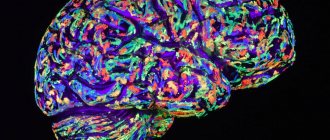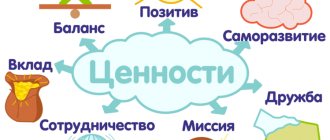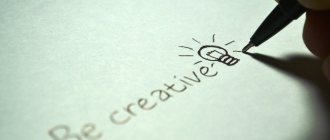Professional and personal growth
A person cannot “just live” and do his job, he must find a goal in which work and profession, and most importantly, he himself and his actions in the profession occupy a certain place.
If the chosen profession does not contradict the formed personal characteristics and the professional development of the individual corresponds to its basic value concepts, then one can expect a value-based attitude to professional activity in the future.
In other words, in this case the unity of personal development and professional growth of the individual is noted.
Consequently, the problem of choosing a profession and mastering an activity is part of the problem of the meaning of life.
In the scientific literature, the problem of professional compliance is associated with the presence of a certain potential of inclinations or abilities that can ensure the successful formation of the necessary professional knowledge, skills and abilities.
There is practically no talk about the harmonious development of the individual, about professionalization as a process that largely determines this development.
It is assumed that everything will be fine with a person if, according to certain parameters, he meets the requirements imposed by professional activity on the subject.
Personal and professional growth helps us further achieve three main goals, on the basis of which we can continue self-improvement in the future:
1. Harmony according to the current day
Studying new information obtained from various sources (books, attending trainings, various seminars), its systematization and further use, taking into account all the requirements necessary for society, including our immediate environment, as well as achieving new heights in building a career;
2. Formation of awareness
Not only real, but also adequate acceptance of the present, a thorough analysis of one’s own behavior model - all these actions are necessary to obtain the necessary list of possible problems and shortcomings that need to be corrected or completely eradicated so that they do not interfere with professional growth in the future;
3. Comprehensive development
Improvement requires not only achieving better results only in a certain category and nearby ones, but also in completely opposite ones.
Thus, you develop comprehensively, which means you can, based on the acquired knowledge and skills, develop in a completely new direction for you. You must not only be an ace in your field, you must also be able to support small talk on any topic.
We offer the following points for drawing up a program of self-educational activities:
- My values;
- My goals;
- My self-concept;
- My perspective (strategy);
- My work tactics and development tasks: cognitive, personal, etc.;
- My actions.
Principles of self-development.
To understand whether the right path has been chosen, it is worth understanding what it involves. What components complement the process of self-development. What sensations or feelings overwhelm a person if he is moving in the right direction. So, 12 principles of self-development.
- The main goal of working on yourself is happiness and harmony;
- The feeling of happiness is in the person himself, and not from his fame or abundance of money;
- You should develop a positive type of thinking;
- Everyone is responsible for their own life;
- Self-development involves working on yourself;
- Learning is an important attribute of development;
- Objectives must be set as achievable and realistic;
- The causes of problems or failures lie in the people themselves;
- A person is capable of changing if he wants to;
- Emotions are controllable and can be managed;
- Self-development is not an easy path, but it is the only correct one;
- There is no need to try to become better than others, in the future you need to become better than your current self.
This process should not be confused with study or professional growth, which is not always chosen by a person. Society tends to impose stereotypes and clichés, but it is up to the individual whether to follow them or not.
Self-development of a person involves improvement on the path to his calling or purpose. All steps along this path should bring positive emotions and give joy. Of course, there may be an “internal struggle” or reassessment of values, but such moments should not be drawn out over time, otherwise the person will drive himself into depression before achieving his goals. Don’t forget that the result of self-development is harmony and happiness. These sensations are not associated with specific material goods. They depend on the totality of all components that are significant for a person, which will be discussed further.
Top 3 secrets of successful people
To achieve success in personal growth, there are special methods, technologies and exercises that allow you to achieve significant changes almost instantly.
For example, in the book by psychologist Nikolai Kozlov, “A Book for Those Who Like to Live or Psychology of Personal Growth,” you can find a diagram that tells you how smart people behave in difficult situations:
Secret No. 1
All you have to do is stop shifting responsibility for the situation onto others - and change your attitude towards it. This is the secret included in all personal growth techniques.
Secret No. 2
Always strive for new knowledge. Seize every opportunity. Regardless of the scope of this knowledge, you can never be sure that one fine day will not come when the skills you accidentally acquired will play an important role in your life.
Secret No. 3.
Share your knowledge with others. For example, with the help of personal growth trainings. Transferring information and discussing it are the best ways to develop. In addition, students can share something new and look at any problem from a different perspective.
Directions and types of self-development
Self-development covers many areas and sectors of an individual’s life. But you shouldn’t try to cover them all at once. Remember the saying about two birds with one stone? The same method applies here - you should not strive to become a piano virtuoso, a doctor of technical sciences and a master of sports at the same time. Spending a lot of effort in general, scattering yourself on many things, it is impossible to achieve absolute success in at least one of them. Multitasking is more an enemy of self-improvement than a helper. There are different types of self-development, you just need to choose the right direction for yourself and focus on achieving your goal in your chosen area. So what is self-development like?
Let's take a closer look at these self-development options:
Intellectual
The development of intelligence is not limited to just reading books
In our modern world there are still many ways to get something new, interesting and - most importantly! – useful information. For example, watching documentaries, attending seminars and lectures, and simply communicating with smart people
Physical
If you do not plan to win medals and cups at the Olympics, then self-development in this area involves giving up bad habits, switching to proper nutrition, maintaining a sleep schedule and doing physical activity. Firstly, strengthening physical health promotes good health, which in turn is the key to advancement in other areas of self-development. Secondly, thanks to physical self-development, your appearance will change, which will be an excellent reason to increase self-esteem.
Spiritual
Spiritual self-development is a very important and necessary process in a person’s life. Negative emotions and feelings bring nothing but destruction to a person. Apathy and depression are a consequence of internal negativity. You need to learn to love yourself and the world around you, forgive minor shortcomings and shortcomings.
It is very important to learn to think in a positive way, because positivity, on the contrary, has the power to create, charges a person with energy and inspires new victories
Cultural
Museums, theaters, art galleries, concerts - these are all methods through which cultural self-development is realized. Attending this kind of event will not only bring you benefits in terms of development and mastery of the cultural heritage of generations, but can also simply bring pleasure and become a way of pleasant leisure time.
Material
Types of self-development include not only improving spiritual qualities. After all, in order to improve the level and quality of your life, you also need to develop. Of course, happiness does not lie in material wealth, but this does not mean that you should not strive for better living conditions or to improve your financial status. As the ironic Scots like to say: “You can’t buy happiness. But it’s much more comfortable to cry in a Mercedes than on a bicycle.”
Professional
You shouldn’t linger in a position that you have long outgrown. Feel free to step up the career ladder and improve your skills. If you are categorically dissatisfied with your job, then you should think about exploring new areas of activity or starting your own business. Don't be afraid to change something in your usual way of life. Remember that your success may depend on your determination.
Personal growth
Before you start working on yourself, you need to decide what qualities you would like to develop in yourself. Personal growth as a type of self-development is training willpower, cultivating desired qualities and character traits, strengthening fortitude, and also eradicating negative characteristics of nature.
Social
It is extremely important to create a comfortable and favorable atmosphere around yourself. You need to learn to interact with colleagues, respect the opinions of friends, listen to your loved ones
Developing tolerance for minor shortcomings of society, sociability, and the ability to control your emotions - all this will only be beneficial and will help you achieve harmony with the world around you.
You can choose one type of self-development and work only in this chosen direction. If you feel strong enough to cover several industries, go for it! Just don’t overestimate your capabilities, don’t try to ideally comprehend all types of self-development - it’s simply impossible to do this at the same time. Work in several directions may sometimes not bring results at all, which can negatively affect the emotional state of the individual and lead to internal “burnout.” Also, ineffectiveness can extremely reduce motivation or completely discourage further action.
Personality orientation in the works of C. Rogers
Rogers is considered one of the best psychologists of the last century, he founded the psychology of humanism. His concept is based on the individual’s desire for actualization; he identifies the following concepts:
- “Real Self” - includes a person’s awareness of thoughts, values, and attitudes in life.
- “Ideal Self” is a set of ideas about how a person sees his future, what he strives for, and his life experience.
- “Social environment” - includes values and norms, behavioral characteristics inherent in a person’s social environment.
If there are discrepancies in life between the real and ideal state of a person and his implementation in society, mental disorders, neuroses, anxiety, and poor adaptation in society arise. To be in harmony with your Self and achieve an ideal state, you need to gain freedom, learn to listen to your inner voice, and act based on your experience and understanding of life.
Usually, problems arise in a situation where a person lives according to the rules of society, trying not to stand out from the crowd, forgetting about the “Ideal Self”. Rogers, working as a psychotherapist, believed that his task was to reveal the potential of the individual, to help determine and gain freedom through self-knowledge.
His “theory” found its application in pedagogy.
Key rules in the work of a teacher
- pedagogy should contribute to the formation of a healthy and adequate personality, promote personal growth;
- the source of development and growth lies in the person himself, only through comprehension and personal experience, responsible choice is it possible to learn and self-improvement of the individual;
- personal growth and development is impossible without understanding and accepting one’s essence. Respect for yourself and your inner world allows you to take risks and reveal new facets of your personality.
Basic qualities of a teacher
- Trusting relationship;
- Stimulate students' internal motivation;
- Share experience, provide assistance in difficult situations;
- Be sensitive to the child’s emotions and feelings;
- Be active in relationships, express your emotions and experiences;
- Understand and know yourself.
Of course, teachers are not always able to find time for each student and promote the full disclosure and development of their personality, so this question applies more to parents who must know and understand their child and help him develop
Each person in the process of his life asks questions of finding himself, his purpose, which is important for further development and self-improvement. “Know yourself and you will know the world,” the sages said
Stages and phases of personality socialization
Socialization is at the core of everything mentioned above. Meanwhile, this is a complex process that includes several stages.
Stages of socialization
- Primary socialization
Occurs from the birth of the child until approximately the age when he starts school. Its agents are primarily parents, as well as other close relatives. Agents are specific people who project certain cultural norms and teach them to a person. They are present in both primary and secondary socialization.
It is in the family, with its original foundations, rules and procedures, that the child’s personality and his own worldview are laid. So, for example, in a religious family, a child from childhood will be accustomed to one religion or another and there will be no other, alternative options for him, since this way of thinking and life in general was instilled in him by the family, the only ones who at that time matters to him.
The process of primary socialization also includes preparation for adult life, through role-playing games in “mother-daughter” or family. Children imitate what they see in the family, and this becomes a necessary stage of growing up.
- Secondary socialization.
It begins when the circle of people important to the child is no longer limited to just the family, usually coinciding with entry into school. Teachers appear, and then friends - that is, other people whose opinions and views the child will listen to, and his horizons will begin to grow. The process of secondary socialization or resocialization lasts throughout life, until a person’s death.
Other, more specific types of socialization are also present.
- Group socialization.
That is, adopting the norms of behavior of a particular social group. Social groups include anything: ethnic group, age group, and professional group. It can be both large, for example, an entire nation, and small.
Each social group has its own characteristics and norms of behavior. A person who finds himself in it, one way or another, to one degree or another must fit into them, otherwise he will not be able to integrate.
- Gender socialization.
It is the adoption of roles that are masculine or feminine. Nowadays, this is difficult to determine, since over the last hundred years these roles, established over centuries, have changed a lot, and there is not always a way to determine what belongs to what and whether there are now gender roles in principle.
Of course, they are also determined by mentality and religion. For example, in Muslim countries gender roles are expressed much more clearly than in European countries and the United States.
In recent years, the issue of transgenderism has also come to the fore in the issue of gender socialization. Due to genetic failures during fetal formation, a person can be physically one sex, but psychologically another. In this case, it is also unclear what to do with gender roles.
There are two global institutions of socialization.
- Primary institutions.
The main and most important thing is family. Next comes the educational institution, peer groups, etc. These are the basic and fundamental institutions, the ones that have the greatest impact.
- Secondary institutions.
They, in turn, are more secondary. These include the state, church, media, etc.
What does self-development consist of?
As we found out, self-development is an activity that is aimed at satisfying human needs. But in order to better understand what it is, you need to understand what types, directions and methods of self-improvement exist. It can be divided into several areas:
- Physical development - development of the body, strength, muscles, endurance.
- Physiological development is an improvement in health, expressed in a beneficial effect on various body systems (cardiovascular, digestive, nervous, reproductive, etc.).
- Mental development is the development of abilities, competencies, skills, abilities through gaining new experiences and sensations, working with perception, thinking, memory, feelings and imagination.
- Social development is the development of abilities and skills, skills and qualities that allow one to climb the career ladder, make the transition between social strata, improve interpersonal relationships, increase social status and authority.
- Spiritual development is knowledge and awareness of oneself, the search for the meaning of life and one’s purpose, taking responsibility for everything that happens to oneself and other people, attempts to understand the nature of the universe and reveal one’s hidden potential, a constant desire for moral and moral self-improvement.
- Intellectual development - the development of thinking through obtaining new information, developing new skills and qualities, increasing literacy, exploring new directions and areas of knowledge.
- Professional development - increasing and developing professional skills, qualities and abilities, studying new technologies and areas of work, obtaining additional education.
The need for self-development can be classified as spiritual (or ideal), but it can manifest itself at absolutely any level. It depends on the direction chosen by the person. No less interesting is the fact that, to a certain extent, each of us is engaged in self-development, and often without even thinking about it and without going into the details of what exactly he is doing.
At a subconscious level, a person chooses the direction that evokes a response in his inner world. And in some cases, the direction dictates the need to acquire certain skills to satisfy certain needs. But the most effective (and also time-consuming) is the conscious choice of the path. And movement along it will always (unless, of course, you want to act chaotically and anyhow) occur in certain stages and obey an action plan.
Self-development - where to start?
Self-development is a person’s constant learning of something new, his desire for knowledge. It is a fundamental part in the development of personality. Self-development begins from a very early age and continues throughout life. A person learns in a variety of ways: he gains new knowledge from books, life experience and, perhaps most importantly, from communicating with people. This is called socialization.
More precisely, socialization is a person’s entry into a social environment through mastery of its social norms, rules and values. A person learns this with the help of other people, society, and without it development is impossible.
And without socialization and self-development, self-realization does not occur, which is the basic need of any person. A person one way or another strives to realize his desires and needs, and he will not do this without a certain set of skills and abilities.
In Maslow's pyramid of needs, self-actualization is at the very top. There is also a need to belong to society and in knowledge, therefore self-development, socialization and self-realization are not just natural stages of personality development, but real needs, without the satisfaction of which life will not be comfortable and fulfilling.
Personal development
- Learn a foreign language.
- Read 1 book per month or week.
- Attend seminars, courses and trainings on self-development.
- Find a mentor. All successful people have had a mentor. Warren Buffett learned the art of investing from Benjamin Graham. Bill Gates learned about the laws of wealth from Warren Buffett. Mark Zuckerberg learned to run a company from Steve Jobs.
- Learn something new every day. Read a new article, learn a new skill, listen to a new talk.
- Find a role model. What kind of person epitomizes who you want to become? I admire Elon Musk, Neil Patel, Brian Dean and Jeff Bezos. I read their books, watch their speeches, study their biography, try to copy their habits and behavior.
Get rid of bad habits
Stop it:
Imagine how many books you can read in this time.
40 pages per hour * 4 hours = 160 pages per day. 160 * 30 = 4800 pages in thirty days. 24 books a month!
How many good changes will happen to you if you read so much? A lot of!
Replace them with good habits
- By reading;
- Sports;
- Studying foreign languages;
- Taking courses;
- Intellectual games;
- Daily planning;
- Yoga;
- Meditation;
- Setting goals.
Self-development and the Wheel of Life Balance
The wheel of life balance is a system of life values. It is necessary to determine the areas of life that currently exist. Usually this:
- Family;
- Job;
- Children;
- Creation;
- Rest;
- Friends;
- Health;
- Love.
You need to select 8 items that are of greatest interest, you can include additional ones not from the list. Then divide the drawn circle into sectors corresponding to the spheres. Analyze the items and rate your own satisfaction in each area. The direction or type of self-development that is a priority depends on this. For example, improving the spiritual, material, social sphere, career growth or starting a family.
Family as a life value
The goal of the method is to achieve harmony; this can be done if the wheel starts to roll. All directions should develop evenly. You need to start restoring balance from the area that is lagging behind. It may later turn out that one of the sectors has lost value and will be replaced by another.
Note! Using the life balance wheel will help you determine what is important and what is not important in life. This is a boost for those who don't understand which direction to move when they seem confused
Take care of yourself physically
Physical capabilities undoubtedly play a very important role in order to feel happy and to experience a better quality of life.
When we feel bad or hurt, we can’t help but be upset about it, feel sorry for ourselves and justify our idleness.
To get rid of this problem, your physical condition must be at such a level that you do not even think about it. You do this by exercising, eating healthy, and getting enough sleep.
Without suitable oil, water, fuel and systematic maintenance, a car cannot drive normally. Its parts begin to fail one by one until the car completely falls apart.
The same happens with our body. Take care of your body. Give him the opportunity to act in your interests, and not vice versa.
❻
Problems of self-realization
Famous psychologists, philosophers, and social scientists have devoted their works to issues of personal fulfillment. Aristotle wrote that the highest happiness can only be achieved through the realization of innate and developed talents.
Maslow spent a lot of time studying aspects of self-actualization. The scientist argued that the need for self-realization and expression of the inner world is located at the top of the pyramid of personal needs. This is a difficult task, because initially it is necessary to overcome physiological needs, feel safe, understand social factors - find friends, love.
According to statistics, only 4% of people can reach the top of the pyramid of needs. Self-realization of an individual in society by 40% allows a person to feel like a happy and full-fledged person.
There is no doubt about the statement that the most important component of a full, harmonious, happy life is the opportunity to use all creative and professional potential.
As a rule, on the path of self-knowledge and development, a person often experiences problems of a psychological nature - a discrepancy between intellectual and energy potential, level of skills and the degree of realization of experience in the real world. Self-realization of an individual in society and in relationships can be difficult for certain reasons:
- living in an unfavorable geographical area;
- physical limitations - poor vision or hearing.
It is important! The discrepancy between aspirations for self-realization and the true capabilities of the individual can lead to pathological deviations in the psyche.
Psychologists identify the main stress factor – the cessation of the prospect of realizing one’s own talents and skills. For example, a promising athlete who was involved in an accident uses a wheelchair. This state of affairs does not allow a person to fully demonstrate his abilities. This will inevitably lead to depression in the future.
Another example is the termination of funding for a successful scientific project. In this regard, professional self-realization of a scientist is impossible.
Every woman experiences the need for self-realization as a mother. The inability to realize one’s direct destiny against the backdrop of constant loneliness transforms into alcohol addiction.
Psychology of Rubenstein
Self-knowledge and self-development of a person occurs in the process of communication with other people, so a person realizes his characteristics and works on personality characteristics. A person’s character is partly an innate thing associated with the type of nervous system, and partly acquired through life and accumulated experience.
To some extent, the study of character is related to Maslow’s theory, since a characterless person does not have a rigid value system, but a person with a strong character clearly understands his purpose and is confident in his coordinate system, adheres strictly to his line of behavior. The concept of “personality” arises as a result of self-awareness of one’s “I” and one’s actions.
Self-knowledge
Self-awareness arises as a result of human development, mastering new knowledge, understanding one’s capabilities, and managing physical processes. Independence develops in the process of mastering speech and service skills, and later manifests itself in the ability to set tasks, goals, and find the main direction for the development of one’s personality.
Self-knowledge and self-development of the individual are important components in a person’s life; these processes are clearly visible in adolescence, when many questions arise before the individual. A person determines his purpose in this world, the abilities and capabilities of his “I”. These are the first attempts to understand yourself.
Each person has character traits and personal qualities that distinguish him from others. Understanding oneself leads to the formation of personality, awareness of the need for changes in certain directions, and the establishment of one’s own principles of life.
A personality is a person with his own worldview, a clear position in life, which arose as a result of great conscious activity, understanding of himself and life in general.
Individuality - a bright, unique person
Personality is a more global concept, and its formation requires quite significant efforts, attention to this issue and determination.
Such a person has his own characteristics, a “handwriting”, and consciously distinguishes himself from the general mass of people, which presupposes independent thinking and the presence of willpower. At the same time, the depth of personality is determined by the richness of the inner world and relationships with people.
Self-isolation leads to devastation of a person, although to a certain extent it is necessary for carrying out internal work and understanding one’s essence. A personality feature is the ability to look at the world from the outside for a more complete understanding of processes.
A developed person also helps others in the process of self-development. A real personality cannot cause indifference; there can be friends or enemies. Such a person always has strength and an active beginning. Self-awareness develops along with a person throughout life; self-reinterpretation occurs in connection with new experiences.
Each person goes through the process of understanding life, asks himself questions and finds answers, understanding what is most important for him and brings value. Accumulated experience and understanding of life leads to the formation of wisdom. Personality is created and built by a person throughout his conscious life, each person develops in a special way.
It is very important to carry out self-knowledge and self-development in a temporary period and ask questions: what was I like? - what am I? - what do I want to be? However, it is important to understand that a person needs to develop his existing potential, and in the process of labor and creation of something, the personality grows. There is a great relationship between a person and his result of activity
Personality
A person is always of interest if he can create something significant and it is clear that this is not the limit of possibilities. The development of personality over time can be tracked through human activity, in which it manifests itself and constantly develops.
A person’s characteristics are not always at the forefront of actions, but can also be a consequence. And abilities develop as a result of constant practice; the more attention a person directs to a certain area, the higher the likelihood of success in it and achieving high results.
Each person has his own life story, which can be reflected in an autobiography or resume; they will contain data about the person’s training, work, achievements - thus, the relationship of human development through activity can be traced.
In order to become a historical figure, you need to do things, create creations that will be in the public domain and go down in the history of society.
The role of the individual’s activity in his own development
Education is a purposeful, meaningful professional activity of a teacher that promotes the maximum development of the child’s personality, the child’s entry into the context of modern culture, and his formation as a subject and strategist of his own life, worthy of a Human Being.
Personality
- this is a person in his social connections and mutual social relationships, he is a member of society, exposed to the influence of the environment, and consciously building his relationships with people and the entirety of social phenomena. The formation of personality does not take place in one act, but proceeds procedurally, like a movement caused by reasons, going through its own stages, having its own pace, its own history.
In the content aspect, education means the teacher’s organization of an educational environment that acts as a factor in the child’s social development due to the fact that it unfolds before him a way of life at the level of high culture, allowing him to master all the achievements of culture and naturally enter into the context of the child’s contemporary culture. The subject of education is always a professional teacher or an adult who consciously and purposefully contributes to the child’s entry into the context of culture.
Criteria for assessing the educational process: Professional
The organization of the educational process necessarily includes a component of pedagogical analysis, thanks to which teachers can verify the correct course of education, its varying degrees of success, and can improve the organized process or adjust its course according to time, the age of the children, events and circumstances.
To evaluate the educational process, two groups of criteria are needed.
The first is for assessing the professional work of teachers: what is the yardstick that can be applied to a teacher’s work to judge whether he is performing his professional work well or poorly?
The second
is for assessing the educational result of this professional work.
First group of criteria
stems from an understanding of education as introducing a child into the context of culture. Signs of culture serve as parameters for the professional work of teachers: civilization as the correspondence of the organized process to the material and technical achievements of mankind; spirituality as involvement of the organized life of children in the problems of humanity; morality as a focus on Man as the highest value of modern culture.
The indicators that will indicate the compliance of professional work with the declared criteria are numerous. The main ones are: the material and technical equipment of the school, the nature of maintaining documents, the distribution of professional functions of teachers in the school, the content of the organized activities of children, the socio-psychological climate in the school, as well as the teacher’s attitude towards the child as a person.
Second group of criteria
is derived from the idea of a worthy Man of modern culture.
Its socio-psychological core is the acceptance of values as the foundations of life. Humanity, intelligence and beauty can be traced in such indicators as the child’s appearance, his spiritual and physical health, behavior as a system of actions, the success of various activities, value preferences and attitude towards himself as a person .
The product of professional pedagogical activity (as harsh as it may sound, but every professional work has its own product) or its result is the upbringing of children.
The more educated the children, the higher the assessment of the teacher’s professionalism. To evaluate the educational process, the key concept of a child’s upbringing is introduced, which incorporates many evaluative characteristics. A student’s upbringing is the degree to which his personal development corresponds to the goal set by his teachers.
The goal serves as some general measure that allows one to judge the degree of pedagogical success.
It is a general criterion for professional assessment of educational results. The measure of good manners
is a measure of compliance with these criteria
6. Content of education. Basic personality culture.
The content of education is understood as
a system of knowledge, beliefs, skills, qualities and personality traits, stable habits of behavior that students must master in accordance with their goals and objectives. The main directions of education - mental, physical, labor and polytechnic, moral, aesthetic education - merged in a holistic pedagogical process, and make it possible to achieve the main goal of education - the formation of a comprehensively and harmoniously developed personality.
The upbringing of a person’s basic culture is closely related to the concept of worldview . One of the leading tasks of educating the basic culture of the individual is the formation of the worldview of schoolchildren. Worldview
represents an integral system of scientific, philosophical, social-political, moral, aesthetic views of the world (i.e., nature, society and thinking). In recent years, views on the content of the educational process have changed quickly and radically. There is no unity today: our society, and with it the education system, is going through a difficult period of comprehending objective truth.
A course has been taken towards the humanization and democratization of education, which should lead to a new quality of education.
The purpose of education today
- diversified development of a person, based on his abilities and talents
.
The means to achieve this goal is for a person to master the basic foundations of culture.
Hence the central concept of the content of education - “basic culture of the individual.”
This is a culture of life self-determination: economic culture and labor culture; political, democratic and legal; moral and environmental, artistic and physical; culture of family relations; culture of behavior.
7) Multifactorial human development. The role of human activity in the process of its development.
The goals of education determine its content, methods and means, the optimal interaction of which should ensure the desired result. It should be borne in mind that the educational process is a multifactorial complex system with a loose ordering of components, which requires constant improvement of management.
In a real situation, decision-making requires operational analysis of not all, but only some factors
Human development
– is also a multifactorial process, depending on a number of objective and subjective factors. Objective factors include socio-historical characteristics, cultural traditions of the country, and the educational system adopted in it; subjective factors include the personal qualities of teachers, the level of their pedagogical skills, psychological characteristics and value orientations of participants in the educational process.
The role of the individual’s activity in his own development
Revealing the most important factors of personality development and emphasizing the determining role of education in this process, one cannot consider a person as a passive object of environmental influences and educational influences. In this process, she attaches great importance to the activity of the individual himself, his creative and transformative activity. Depending on this activity and the internal position of the individual in relation to environmental and educational (external) influences, it can be formed in a variety of directions. If a student has a negative attitude towards these influences, he will develop in the direction directly opposite to that towards which the teacher directs him. For example, when testing knowledge, a teacher unfairly underestimated a student’s grade, and the latter was offended. In this case, all the teacher’s calls to improve academic performance will cause hidden and sometimes open resistance in the student. And this happens in all cases when the educator and his pedagogical influence do not find a positive response in the internal sphere, i.e. in the consciousness and feelings of the student. Understanding of this phenomenon has led to the fact that all impacts and influences that affect the development and formation of personality began to be divided into two groups - external and internal. Environmental influences and upbringing are among the external factors of personality development. Natural inclinations and inclinations, as well as the entire set of feelings and experiences of a person that arise under the influence of external influences (environment and upbringing), belong to internal factors. The development and formation of personality is the result of the interaction of these two factors. It is quite clear that education plays a decisive role in the development of an individual only if it has a positive impact on the internal stimulation of her activity in working on herself. It is this activity and the growing person’s own desire for personal improvement that ultimately determines his development.
8.Methods of education and their classification.
Education methods
- these are ways of interconnected activities of educators and students aimed at solving educational problems. I.F. Kharlamov clarifies: methods of education are a set of methods and techniques of educational work for the development of the need-motivational sphere and consciousness of students, for the development of behavioral habits, its adjustment and improvement.
Educational means
- These are relatively independent sources of personality formation. These include types of activities (work, play), objects, things (toys, computers), works and phenomena of spiritual and material culture (art, social life), nature. The means also include specific events and forms of educational work (evenings, meetings). Some believe that means is a broader concept that includes methods, forms and the means themselves.
Knowledge of methods is facilitated by their classification (dividing objects into groups according to some criterion). In pedagogy there is no strictly scientific classification of methods. Five methods have been empirically identified and most studied: persuasion, exercise, example, encouragement, punishment. One of the latest classifications is based on the concept of activity, according to which three groups of educational methods are identified according to their place in the educational process
(Yu.K. Babansky).
1 gr.
Methods of forming the consciousness of the individual (views, assessments).
2 gr.
Methods of organizing activities, experience of behavior.
3 gr.
Methods of stimulating activity and behavior.
The identification of the first group is based on the principle of the unity of consciousness and behavior. Consciousness as knowledge, a set of ideas about the world, determines behavior and is simultaneously formed in it. The second group of methods is identified on the basis of the thesis about the formation of personality in activity. The third group reflects the need-motivational component of activity: approval or censure of an action shapes behavior. Methods of education according to this and other classifications are described below.
The choice of parenting methods depends on the degree of inappropriate behavior of the child, his age, temperament and parenting style.
9. Methods of forming the consciousness of the individual:
Education should shape the required type of behavior.
The first stage of properly organized upbringing is the knowledge (understanding) by the pupil of those norms and rules of behavior that should be formed in the process of upbringing. It is difficult to educate or develop any quality without first achieving a clear understanding of the meaning of this quality. To form views, concepts, and beliefs, methods are used that have received the general name of methods for forming the consciousness of an individual. These include: Story
- this is a consistent presentation of predominantly factual material, carried out in a descriptive or narrative form;
A conversation
is a question-and-answer method of active interaction between a teacher and a student.
A more complex method of organizing cognitive activity - a lecture -
is a detailed, lengthy and systematic presentation of the essence of a particular educational, scientific, educational or other problem.
The basis of the lecture
is a theoretical generalization, and the specific facts that form the basis of the conversation serve as an illustration or starting point in the lecture;
Persuasion is a multifaceted influence on the mind, feelings and will of a person in order to form the desired qualities in him. Depending on the direction of the pedagogical influence, persuasion can act as evidence, as suggestion, or as a combination of both. Dispute
– a clash of opinions with the aim of forming judgments and assessments.
An example as a method of pedagogical influence
is based on the desire of students to imitate. It has long been known that words teach, but examples lead. By peering into other people, observing and analyzing living examples of high morality, patriotism, hard work, skill, fidelity to duty, etc., the student understands more deeply and clearly the essence and content of social and moral relations. The personal example of the teacher-educator (imitation) is of particular importance.
10.Methods of organizing activities and developing behavioral experience
Positive experience of behavior is created through pedagogically correctly organized activities of children, which is the source of education in this group of methods. Education in activity has a number of patterns on the basis of which requirements for its organization are formed. An activity educates if it is personally significant for children and has “personal meaning” (A.N. Leontyev). The position of the students must be active, and their functions must change: everyone takes on the roles of performers and organizers. Management of children's activities should be flexible, corresponding to the pedagogical situation.
In domestic pedagogy, organizing children's activities is the leading method of education. This group of methods includes training, pedagogical requirement, exercise, public opinion, and educational situations.
Pedagogical requirement
is understood as the presentation to fulfill certain norms of behavior, rules, laws, traditions accepted in society and in its groups. A requirement can be expressed as a set of norms of social behavior, as a real task, or as a specific instruction to perform an action. The form of demands can be direct or indirect. The first ones have the form of orders, instructions, instructions, and are distinguished by a decisive tone, especially at the initial stage of education. Indirect demands are presented in the form of a request, advice, hint; they appeal to the experiences, motives, and interests of the students. In a developed team, indirect demands are preferable.
Public opinion
is an expression of a group demand. It is used in developed teams when evaluating actions. The teacher must form a healthy public opinion by stimulating student performances and evaluating their performance.
Training and exercise contribute to the formation of sustainable behavior patterns and habits. Habituation is the organization of children’s regular performance of actions in order to transform them into habitual forms of behavior. Habits become stable properties and reflect the conscious attitudes of the individual, which is why it is so important to form them. Training is effective in the early stages of development. The technique requires explaining to students what, how and why to do. Accustoming also involves checking the execution of actions.
Exercise
— repeated repetition and improvement of methods of action as a stable basis of behavior. In a broad sense, this is an organization of children’s lives and activities that creates conditions for actions in accordance with social norms. The exercise is based on habituation, is closely connected with it and is implemented through an assignment, fulfilling a role in the overall activity. Participation in collective affairs at all stages (planning, execution, evaluation) develops abilities and shapes personality traits. Training and exercise are effective if they are based on positive motives for activity and, in turn, shape them.
Educational situations
- these are circumstances of difficulty, choice, impetus for action; they can be specially organized by the teacher. Their function is to create conditions for conscious active activity, in which existing norms of behavior and values are tested and new ones are formed. These could be situations of conflict in a group, choosing the right solution, etc.
11.Methods of stimulating behavior and activity:
To stimulate means to induce, to give a push, an impulse to thought, feeling and action. In order to reinforce and enhance the impact of certain factors on the student’s personality, various stimulation methods are used, among which the most common are competition, encouragement, and punishment. Competition
. Competition in educational institutions is akin to the best examples of sports competition. The main task of the teacher is to prevent competition from degenerating into fierce competition and the desire for superiority at any cost. Competition should be imbued with a spirit of comradely mutual assistance and goodwill. Well-organized competition stimulates the achievement of high results, the development of responsibility and initiative.
Promotion
- this is a signal of self-affirmation, because it contains public recognition of the approach, the mode of action and the attitude towards action that are chosen and implemented by the student. The feeling of satisfaction that a rewarded student experiences gives him a surge of strength, an increase in energy, confidence in his abilities and, as a result, is accompanied by high diligence and effectiveness. But the most important effect of encouragement is the emergence of a strong desire to behave in such a way and act in such a way as to experience this state of mental comfort as often as possible. The pedagogical feasibility of encouragement increases when working with students who are timid, shy, and unsure of themselves. At the same time, encouragement should not be too frequent, so as not to lead to devaluation and expectation of reward for the slightest success. The subject of special concern of the teacher should be to prevent the division of pupils into those who are praised and those who are ignored. The most important condition for the pedagogical effectiveness of encouragement is integrity, objectivity, understandability for everyone, support by public opinion, taking into account the age and individual characteristics of students.
Punishment
- one of the oldest methods of education.
Justifying the legitimacy of punishment as a method of educating A.S. Makarenko wrote: “A reasonable system of penalties is not only legal, but also necessary. It helps to develop a strong human character, fosters a sense of responsibility, trains the will, human dignity, and the ability to resist temptations and overcome them.” Punishment corrects the student’s behavior, makes him think about where and what he did wrong, and causes a feeling of dissatisfaction, shame, and discomfort. The pedagogical requirements for the application of penalties are as follows:
*you cannot punish for unintentional actions; *one cannot punish hastily, without sufficient grounds, on suspicion: *it is better to forgive ten guilty people than to punish one innocent person; *combine punishment with persuasion and other methods of education; *strictly observe pedagogical tact; * rely on understanding and support of public opinion; *take into account the age and individual characteristics of the pupils.
12) Personality education in a team. Development of the theory of the collective in the works of Makarenko, Krupskaya, Sukhomlinsky.
N.K. Krupskaya gave a comprehensive justification for the benefits of collective education of children and adolescents. In her numerous articles and speeches, she revealed the theoretical foundations and showed specific ways to form a children's team. N.K. Krupskaya considered the team as an environment for the development of the child and attached great importance to the organizational unity of children in conditions of collective activity.
A.S. made a particularly significant contribution to the development of the theory and practice of the team. Makarenko. He proved that “no method can be derived from the idea of a pair: teacher + student, but can be derived from a general idea of the organization of the school and the team”[4]. He was the first to deeply substantiate the harmonious concept of the educational team, permeated with humanistic ideas. The pedagogical principles that he laid as the basis for organizing the children's team provided a clear system of responsibilities and rights that determined the social position of each member of the team.
Consistent development of the idea of A.S. Makarenko received in the pedagogical works and experience of V.A. Sukhomlinsky. Seeing the task of the school as ensuring the creative self-development of the student’s personality in the team, he made and implemented a successful attempt to build an integral pedagogical process. V.A. based his educational system of creative personality development. Sukhomlinsky put forward the idea of directed development of a child’s subject position
collective is a highly developed group with such characteristics as cohesion, purposefulness, value-orientation unity, etc. Pedagogy understands the educational collective as an association of pupils, whose life and activities are determined by socially significant goals, self-government bodies, and interpersonal relationships are collectivist, i.e. are determined through their relationship to the common cause.
This definition contains four characteristics of a group of pupils, indicated by A. Makarenko: the presence of socially significant goals and activities, self-government bodies and collectivist relations. In psychology, groups differ in different ways. For pedagogy, it is important to divide groups by level of development: diffuse groups, associations, corporations, teams, and by size: large, small. A. Makarenko identified primary teams of 10-15 people who are in direct contact, and school-wide teams. In group theory, it is important to know the concept of “group formation”, its variant “collectivization”, the transformation of a group into a collective, as well as “collectivist self-determination” - the attitude towards a group through group ideals, norms, values. Phenomena and processes in a small group are reflected in their own way in the pedagogical theory of the group by A. Makarenko.
13) Signs of a team. Dynamics and stages of development of a children's team.
By collective we mean: 1).
a group united by common experiences, common interests, common work, common views, friendship
(N. N. Krupskaya);
2)
“a social living organism, which is an organism because it has organs, that there are powers, responsibility, correlation of parts, interdependence, and if none of this is there, then there is no collective, but there is a crowd or gathering”
(A. S. Makarenko ;
3)
an organized group in which its members are united by common values and goals of activity that are significant for all children, and in which interpersonal relationships are mediated by the socially and personally significant content of joint activities
(V.A. Slastenin, I.F. Isaev)
*** signs of childhood collective (based on the definitions of this concept):
1.
the presence of socially significant goals, their consistent improvement;
2.
the presence of self-government bodies and ensuring their effective operation;
3.
the presence of positive traditions and exciting prospects;
4.
atmosphere of mutual assistance and trust;
5.
developed criticism and self-criticism, conscious discipline;
6.
developing the right public opinion;
7.
major lifestyle of the team;
8.
ensuring the unity of public and individual
Signs of a collective (according to T.E. Konnikova):
1.
stable friendly relationships, attention to each other
2.
lack of isolation, isolation of the team, general desire to interact with other teams
3.
the presence of a sense of security among team members
.
Signs (according to A.N. Lutoshkin and L.I. Umansky) 1.
integration
2.
microclimate
3
.
referentiality (the degree to which members of the team accept the group standard) 4. leadership 5. intragroup activity 61 intergroup activity is also a sign of its socio-psychological maturity.
***Stages of development of the children's team:
The stages of development of the team were first characterized by A.S. Makarenko. He considered a necessary condition in the development of a children's team to be a natural transition from the categorical demand of the teacher to the free demand that each individual places on himself against the background of the demands of the team.
at stage 1
the teacher’s individual demands on students, expressed in a form that does not allow for objections, should act as a means of uniting children;
indicators of the transition of the diffuse group to the second, more qualitative, stage of development of phenomena. major style and tone, stability and clear highlighting of a real active asset; at the second stage:
the teacher proceeds to using
the parallel action method.
at the second stage , the structure of the team is formalized and stabilized. the team acts as an instrument of purposeful education, an integral system. The task of the teacher is stimulation, use of the team’s capabilities for the purpose of individual development of each individual student.
third stage
grows organically from 2, merges with it and is characterized by the fact that the requirements are presented by the team itself. at this stage, the team becomes an instrument of individual development, self-development of each member. Of great importance for the development of the team is the organization of the long-term aspirations of students, i.e. The law of collective movement discovered by A. S. Makarenko. If the development and strengthening of a team largely depends on the content and dynamics of its activities, then it must constantly move forward and achieve more and more successes.
20) Movement of innovative teachers of the 80s.
(other names: author's pedagogy, innovative pedagogy) took shape in the early 1980s, one of the first, like the rock movement, in the wave of 1985-2010.
It originated at the intersections of many movements. Let us list: the communard movement, the RVO movement, the memorial movements of Montessori and Waldorf schools that came to us from the West during the era of perestroika, the training culture and cooperative movement of the same time, the ODI movement, the summer school movement, many innovative pedagogical initiatives of Soviet teachers and teachers (for example , A. Tubelsky, A. Karakovsky, Sh. Amonashvili, E. Bondarevskaya, I. Volkov, E. Ilyin, S. Lysenkov and many others).
The movement was transmitted through seminars, training camps, and open master classes, where elements of the innovators’ original programs were demonstrated. The animator was the initiative of V. Matveev (at that time editor of the Teacher's Newspaper) to create the Creative Union of Teachers of the USSR, which united many innovative teachers: Sh. Amonashvili (primary school teacher, deputy of the Congress of Soviets), V. Aprausheva (director of the Zagorsk boarding school for the blind -deaf children), E. Dneprov (future Minister of Education) and others. An even greater role in the animation of the movement was played by state policy during the era of perestroika, when TV programs were made, books were published, articles were published about the most striking innovative initiatives - Viktor Shatalov (method of supporting notes), Mikhail Shchetinin (method of immersions), Oleg Gazman (basic culture and self-determination of personality) and others. ***The need side of the emergence of the movement was the Response to the crisis of the educational system during the transition from the industrial phase of the development of society to the post-industrial one. The phase transition (note that our society has not been able to overcome it so far) required changes in the basic psychotype formed by the educational system. Society was moving away from “conveyor belt” methods in education that shape performers, and demanded changes in the education system to fill the entrepreneurial niche, the scope of which was opened during perestroika. The proof of this thesis is the slang that became most popular at that time among innovative teachers: individual approach, student-oriented pedagogy, humanistic education, individual educational trajectory, formation of a tolerant personality, etc. ***In fact, new educational tasks were set, which is reflected in the name of the movement - innovative teachers, and not innovative teaching, for example. It is interesting to note that the main breakthroughs, however, were made by the movement precisely in the area of creating new educational (not educational) methods, since the main goal was the creation of the New School. Dozens of new approaches to teaching have been developed: interdisciplinary courses and immersions, educational trainings, didactic role-playing (based on action) and organizational activity (based on mental activity) games, project methodology, integrated lessons, research laboratories in various subjects, teaching via computer, tutoring , new approaches to assessing the educational process, different types of Olympiads, etc.*** New objectives of education have been formulated: the development of thinking as opposed to encyclopedicism, the development of communication, tolerance, the ability to make decisions and bear responsibility, the ability to work at the intersection of different subject areas, quickly navigate information flows, the ability to work in a team in a project-based way, the ability to formalize and present the result, mastering text culture and other humanitarian technologies... New methods of motivating children in the educational process have been mastered: research type, construction, game, club and others.
***The movement reached its peak in the early 1990s, after which it split into separate branches of submovements: the movement of private schools, where many of the passionate teachers went, the association of teachers of innovative pedagogy “Eureka”, headed by A. Adamsky (unites mainly , state educational platforms), the Montessori school movement (it spread in Russia thanks to the selfless activity of Elena Hiltunen, who came from a communitarian environment), distance education, etc.
***The size of the movement is estimated at several thousand active members and several tens of thousands of passive ones, making up the aura and audience of the movement.
***By the late 1990s and early 2000s, the movement began to move into the memorial phase of development. Partially disintegrated, partially degraded from movement towards the current. Today, the remnants of the movement are quite capable of taking part in the new Synthesis.
Effective methods of self-development
Sometimes you really need to look at yourself from the outside. There is nothing complicated about this, just set up a camera and capture your everyday actions on video. In the professional sphere, this will also help to hone your skills and see your own shortcomings.
Quite often, many psychoanalysts call to “let go of your past.” But this is not a completely correct method. Yes, somewhere it is really needed, but it doesn’t get better for those who decide to develop. It is impossible to notice personal changes if there is nothing to compare them with. Therefore, sometimes it is useful to look at your past self in order to see changes for the better and personal growth.
The twenty-first century is oversaturated with information, sometimes our brain simply cannot cope with it, experiencing emotional and mental overload. If you notice such an alarming state in yourself, urgently arrange a rest for yourself! The main thing during relaxation is not to get stuck in gadgets or the Internet, but to completely distract yourself from the unnecessary flow of information. And besides, with a “fresh mind”, much more interesting ideas that are profitable for implementation come up!
If the risk is justified, then it is quite appropriate. As for senseless risks, you should be careful here in order to avoid unnecessary losses and failures in the future. Professional self-development sometimes requires passion and risky actions, the main thing is not to get too carried away with it.
Society and self-development
For self-development, it is so important to invest in yourself rather than in something else. Education, travel, proper nutrition, sports - all this is the key to good health + independent development
When you are faced with many different tasks, it is difficult not to forget everything. Keeping a planner or regular diary will make some of the work easier for you. As for professional self-development, you can’t live without a notebook! After all, who knows when another brilliant idea will come to your mind.
Using the above self-development methods, you are sure to achieve effective results in all your work endeavors!
Goals and ideas
Set the right goals to achieve which you have taken the path of self-development. If necessary, do not be afraid to ask questions of your own “I”. Only in this way will you determine whether you are really moving in the right direction, or whether you are faced with severe self-deception.
Any correctly set goal has guidelines that help in achieving it. Take care of them and you will definitely achieve the desired result!
Without good motivation, the process of self-improvement may well drag on for many years. Find a worthy example for yourself that will serve as a real incentive for you. For example, your boss or senior management would be a great example.
If you move in only one direction, it will be very difficult for you to achieve complete self-realization. In moderation, engage in both the physical development of your body and the improvement of your intellect, gradually increasing your IQ level.
Practical recommendations
- First of all, you need to competently and realistically assess your own talents and abilities. To do this, psychologists recommend taking a sheet of paper, creating a calm, relaxing environment and writing down the qualities and hobbies that need to be worked on.
- Honestly and impartially write down all your character traits, regardless of how much they are valued by society.
- List all the types of activities in which you would like to realize yourself. Think about your dreams, what you wanted to do as a child. As psychologists note, childhood dreams reflect a person’s true personality. Next to each activity, write down the necessary character traits that will help you achieve success. After all, only in activity does self-realization of the individual occur.
- Compare the lists and this way you will see which type of activity suits you best. At first glance, this method is only suitable for teenagers who have not decided on a profession. However, according to statistics, most adults are not satisfied with their work and would like to change their type of activity. Such dissatisfaction is dictated, first of all, by the inability to correctly identify one’s talents and set life priorities.
- Many people mistakenly believe that they can only realize themselves in professional activities. However, this is a general misconception. It is necessary to abstract from traditional views and evaluate yourself comprehensively. It is quite possible that a person will be able to express himself while on vacation or while doing his favorite hobby. The main thing is that the process is enjoyable - this is the main sign that the self-realization strategy has been chosen correctly and is successful.
Watch the video - an expert’s opinion on personal self-realization and finding a worthy goal in life.
Methods of personality development: biography of great people
Studying the biographies of historical figures and contemporaries helps not only to identify the patterns that led them to success. In many cases, this method gives a charge of motivation, an example of courage and perseverance in any life circumstances. Every person has fear within them at the genetic level.
It is needed in order to protect a person from inevitable death every time. People no longer live in caves, and their lives no longer hang in the balance depending on the decisions of the community. But fears of all kinds - from phobias to social fears - sit deep in every person. All methods of personality development, one way or another, have as their goal overcoming inappropriate fear in a person.
It can be difficult for the modern generation to understand that the habit of heroism can be trained. Samurai, scientists burned for the truth - they all appear before us like shadows of the past. But history has thousands of examples of human heroism. Studying the biographies of both successful people and historical heroes is a powerful method that will allow you to look at life from a slightly different perspective. After all, for the majority, heroism is a gift that is given to a few. Not every artist becomes Raphael, and not every scientist becomes Einstein. Only a few athletes become champions.
But it’s worth studying the biographies of great people in more detail, and it turns out that leadership, intellectual development of the individual, and heroism are the work of ordinary people of flesh and blood. “It was not the gods who fired the pots,” said the ancient Greeks. Consider, for example, the inspiring story of Podolsk cadets - an example of the greatest feat, the result of which was the salvation of the Russian capital from the fascist invaders.











